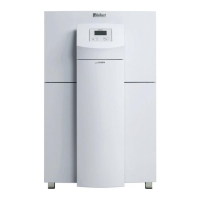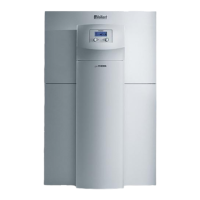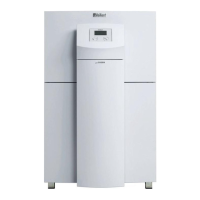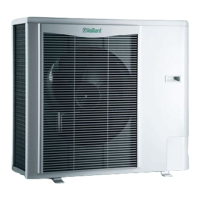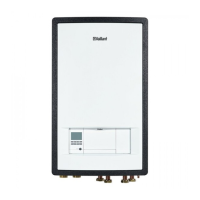Hydraulics installation
30 Installation instructions geoTHERM 0020051574_04
5
5.4 Installing the mixed circuit with buffer tank
and DHW tank
5.4.1 Description of functions for the heating
mode with buffer tank and DHW tank
The heating circuits are connected as a separating tank to
the heat pump via a buffer tank and are operated using an
external heating circuit pump via a heating circuit mixer.
By default, this is controlled by a flow temperature setpoint
control (¬Ch.9.4.3).
The VF2 flow temperature sensor sits behind the external
heating circuit pump (underfloor protective circuit).
The heat pump responds to a demand for heat from the
buffer tank.
The heat pump also operates a DHW tank.
5.4.2 Installation instructions
> Install the hydraulic components in accordance with the
local requirements and as shown in the sample hydraulic
scheme below.
> If you do not use the optional accessory heat pump brine
filling unit for heat pumps (56) (¬Fig.5.5) , install the
individual hydraulic components accordingly (¬Fig. 5.9).
> Connect a limit thermostat to ensure the underfloor
heating function on the heat pump.
> Connect the VF2 flow temperature sensor to ensure the
integral energy function.
> When starting up the unit, set Hydraulic Scheme No 4 in
the controller.
You can choose to use the VPS/2 multi storage tank as a
DHW tank.
> When connecting the hydraulics, observe the
¬ installation instructions for the cylinder and the
¬ geoTHERM planning information.
The 1” diverter valve supplied in the VPS/2 multi storage
tank must be replaced by two 3-way diverter valves that
must be installed on-site. The diverter valves must be con-
nected to the LP/UV1 terminal on the controller PCB (2)
(¬Fig. 7.1 8).
i
As of VWS/VWW 380/2, the VPS/2 1500 multi
storage tank must be used.
The following only applies when installing the optional
external passive cooling:
b
Caution!
Risk of malfunction in cooling mode.
The buffer tank must not be in operation
during the cooling mode of the heat pump.
> Install a motor-driven 3-way diverter
valve in both the flow and return so that
the buffer tank is avoided in cooling
mode.
Caution: Schematic only!
These examples of hydraulic schemes do not contain all of
the shut-off and safety instruments that are required for
correct installation.
> Observe the applicable standards and regulations.
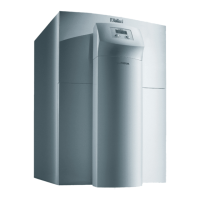
